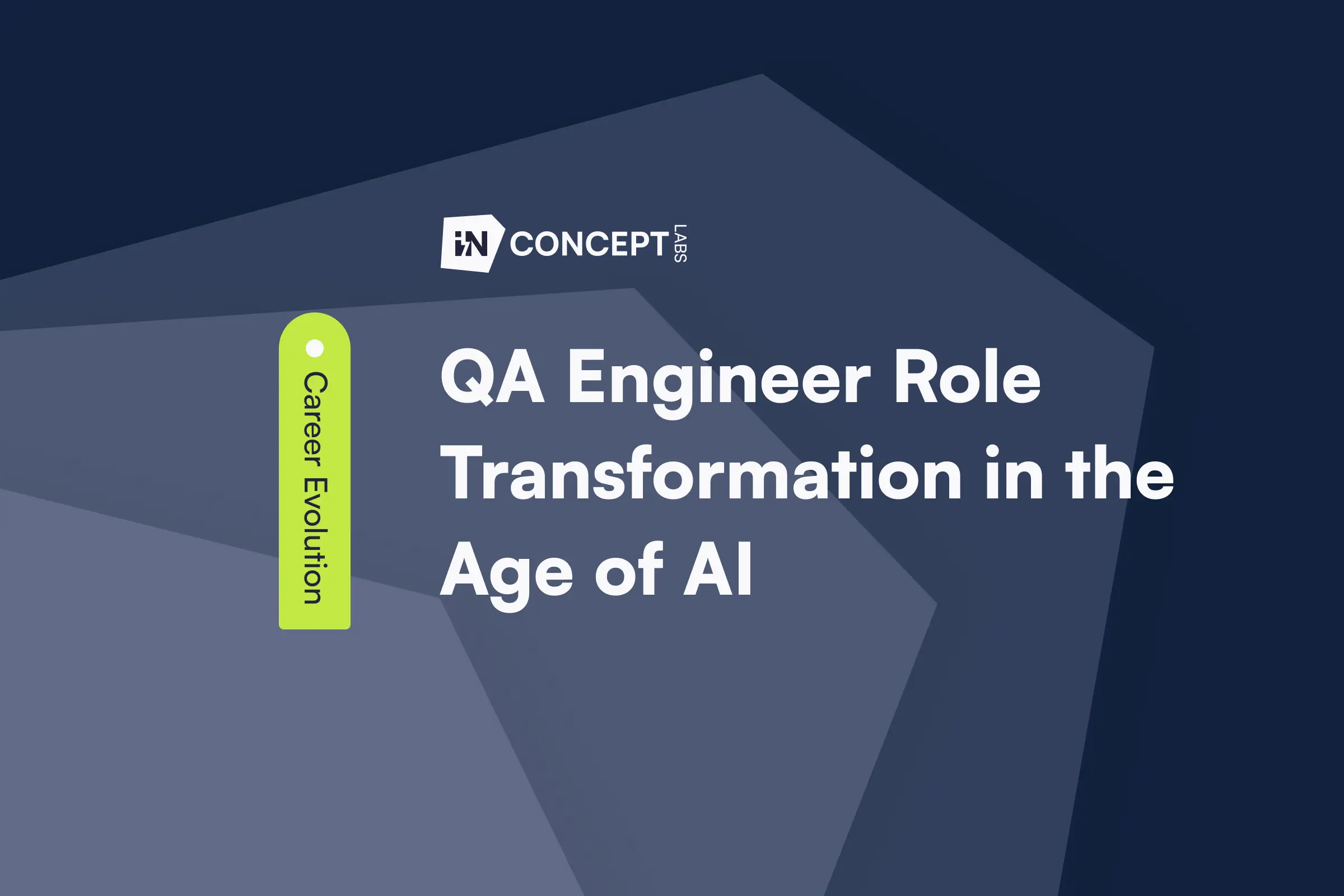QA Engineer Role Transformation in the Age of AI
October 10, 2025
 by Yerem Khalatyan
by Yerem Khalatyan
At InConcept Labs, we’re on a mission to lead the AI transformation and stay ahead of how technology reshapes software engineering. As part of this, we regularly hold goal-setting sessions across all our engineering groups to make sure every discipline is evolving with intention.
While the AI transformation in software development is fairly clear, for QA engineers, it’s not so obvious. After months of research, hands-on experiments, and team discussions, we’ve defined a focused direction for our QA engineers. And here I would like to share what we’re encouraging them to prioritize over the next 12 months to stay competitive in the market.
We no longer draw a strict line between manual and automation QA roles because, in practice, they are blending more and more each year.
AI-Augmented Test Case Management
The first key area of transformation is what we call AI-Augmented Test Case Generation and Management.
And this is not just asking ChatGPT to “write test cases.” It’s about using AI as a real productivity booster to keep product specifications and test documentation synchronized; something every QA engineer has struggled with for years.
Keeping test cases up to date as a product grows is one of the hardest and most time-consuming challenges. In most teams, it simply doesn’t happen because there’s never enough time or resources. That’s where large language models (LLMs) can truly shine, since they understand context, track text changes, and manage version changes better than humans can.
Here’s the approach we use and recommend:
Step 1: Unify your test case format
Make sure every test case follows the same structure and rules.
If your QA management tool includes AI assistance, then use it.
If not, you can easily create your own setup:
- Create a Custom GPT.
- Provide your product specs and a set of well-written test cases as a knowledge base.
- Define clear generation rules and instructions.
- Ask everyone on the team to follow those same rules.
If an AI-generated test case looks wrong, don’t fix it manually. Instead, think about what information the model might be missing. Add that missing context or update your instructions until it produces the right result.
Step 2: Create the initial version of your product specification
If your product documentation is outdated or scattered across drafts, feed all your test cases into your LLM and ask it to build a clean, structured specification. After one careful manual review, you’ll end up with a single source of truth, which is a synced specification and test case set.
Step 3: Keep everything in sync
This is the part where the real magic happens. This is also where AI begins to save you the most time and effort.
Whenever a new feature is added or an existing one changes, do not write test cases by hand. Instead, describe the change to your Custom GPT just as you would explain it to a teammate. For example, you might say, “We added a new field on the user form and removed password confirmation.” Then, ask it to update your product specification and clearly mark what was added, changed, or removed.
After that, review the updated specification manually to make sure everything looks correct. Once you approve it, ask your Custom GPT to refresh all related test cases automatically. It will rewrite or create new ones where necessary, and again show you exactly what was modified.
Step 4: Pushing changes back to your test case repository
Now that you have updated and generated your test cases, it is time to push the changes back to your test repository. Depending on your toolset and infrastructure, you can utilize some automations here or set up MCP and API integrations from ChatGPT to, for example, TestRail directly.
Many QA automation products are already working in this direction, and very soon, this automation flow will be supported by leading vendors. But before that happens, you can accomplish all this setup in 3–5 days maximum.
E2E Automation Testing
Automation testing is not a new concept, but it has become more important than ever. Almost every QA job description now lists automation as a required skill, and there are good reasons for that.
The Challenges before AI
- Writing a single automated test often took hours.
- Tests broke frequently as product flows evolved, creating a maintenance burden.
- QA engineers needed significant coding skills to keep up with complex automation frameworks.
The Breakthrough With AI
- AI tools such as Cursor, GitHub Copilot, and others make test creation much faster.
- Maintenance is easier because AI can suggest fixes and adapt test flows.
- Manual testing alone is no longer enough, since code is now produced at much greater speed.
Recommendation
Automation has become a core skill for every QA engineer. You do not need to design frameworks or pipelines from scratch, but you should be comfortable working inside existing ones.
Start with:
- Basic TypeScript or Python programming knowledge.
- The Playwright framework.
- Confidence using Cursor AI for fast, AI-assisted coding.
This is one area where AI-driven development is not only acceptable but highly recommended.
LLM and ChatBot Testing
This is one of the newest and most exciting areas of QA. Some people believe LLM testing should be the responsibility of developers, but QA engineers are ultimately responsible for verifying that the entire application works as expected, including its AI components.
Testing LLMs is not deterministic. The same input can produce different outputs, which means QA engineers must develop new habits and use new tools. Unfortunately, there are still few formal learning resources for this type of testing, so curiosity and experimentation are essential.
Recommendation
This will soon become one of the most valuable skills in testing. Almost every new product claims to use AI, which usually means it includes an LLM or a chatbot.
Start with the following steps:
- Learn how LLMs work. Even a short introductory course helps you understand the types of errors they produce.
- Study prompt engineering, focusing especially on system prompts. Learn how models such as OpenAI, Anthropic, and Google differ in context handling.
- Understand RAG (Retrieval-Augmented Generation), since many issues occur at this layer, and QA engineers can make a big impact by testing it thoroughly.
- Explore labeling and evaluation tools that help classify and score LLM responses for quality and relevance.
Using AI for test case execution
Manual test execution remains one of the most time-consuming parts of QA. It takes hours of repetitive work but is still critical for catching issues that automation often misses, such as visual bugs or unexpected user flows.
Many startups are now trying to automate this process with AI. The goal is to create agents that can understand the interface, navigate through it, and verify results just like a human tester. It is an exciting idea that could save huge amounts of time.
However, as of October 2025, none of the tools we have tested are stable or accurate enough for real use. The main challenge is that user interfaces are dynamic and context-dependent. AI can click buttons and fill forms, but it still struggles to understand intent or validate visual details correctly.
The technology is evolving fast, but for now, it is better to keep an eye on this field and wait for the next big leap before fully relying on it in production environments.
Summary
For the next 12 months, AI is not a threat to QA engineering jobs. Instead, it is becoming a powerful tool that raises both the expectations and the potential of the QA profession. The role of the QA engineer is expanding, becoming more technical, analytical, and creative than ever before.
To stay competitive, every QA engineer should focus on developing new, AI-driven abilities:
- AI-Augmented Test Case Generation is now an essential skill.
- Prompt Engineering is key to communicating effectively with modern AI tools.
- Automation Testing is a required part of every QA engineer’s daily work.
- LLM and Chatbot Testing opens doors to entirely new testing directions.
- AI for Test Execution is worth watching closely as it matures.
The QA profession is not being replaced. It is evolving. Those who adapt early will not only stay relevant but will lead the way in defining what quality means in the AI era.
Recommended learning materials
Playwright
- https://playwright.dev/docs/intro
- https://www.udemy.com/course/playwright-tutorials-automation-testing/
Prompt engineering
- https://www.coursera.org/specializations/prompting-essentials-google
- https://www.deeplearning.ai/short-courses/chatgpt-prompt-engineering-for-developers/
Building Custom GPT
LLM and RAG
Share this post